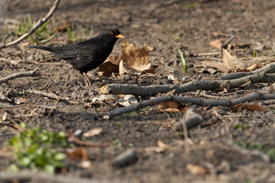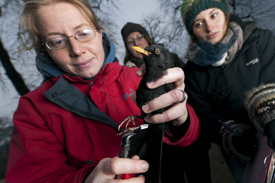Press release, 24 September 2013
Artificial lighting and noise alter biorhythms of birds
Nights are definitely shorter in the city centre
Leipzig. Noise from traffic and artificial night lighting cause birds in the city centre to become active up to five hours earlier in the morning than birds in more natural areas. These were the findings from an investigation conducted on 400 blackbirds in Leipzig by the interdisciplinary research group "Loss of the Night". Scientists from the Helmholtz Centre for Environmental Research (UFZ) reported in the open-access journal PLOS ONE that these findings showed how ambient noise and light pollution caused by humans have significant effects on the behavioural patterns of city blackbirds, affecting their natural cycles
 Road noise and artificial light ensure that birds in the city centre are up to five hours earlier active in the morning than their fellow species in the quieter neighborhoods. This is the result of a study of more than 400 blackbirds in Leipzig, which was carried out during the research project "Loss of the Night".
Road noise and artificial light ensure that birds in the city centre are up to five hours earlier active in the morning than their fellow species in the quieter neighborhoods. This is the result of a study of more than 400 blackbirds in Leipzig, which was carried out during the research project "Loss of the Night".
Photo: André Künzelmann / UFZ
The scientists choose the Common Blackbird (Turdus merula) as the model organism for the investigation. This medium sized thrush was originally a forest-dweller, but since the early 19th Century it has become well-adapted to the conditions of cities, where it is now a common resident that is easily identified by its very distinct birdsong. In spring of 2011 and 2012, both over 15 weeks, data on the behaviour of blackbirds were recorded and analysed in the 215-hectar study area in Leipzig. The study area covered an urban gradient of 3km stretching from the city centre through the Clara Zetkin Park to the floodplain forest.
For biologist Anja Ruß and some hard-working students the field work involved numerous nightshifts of patrolling blackbird territories between 1:30am and sunrise to record the birdsong behaviour of male blackbirds in order to locate and record the behavioural patterns of over 400 individuals. In addition, the scientists used data from official statistics for calculations on the distribution of artificial lighting and noise levels of the surrounding environment. Due to the artificial lighting of roads it was much brighter at night in the green areas close to the city ring road than in the floodplain forest. "The brighter the night, the earlier the blackbirds started their dawn song. We found this linear relationship for low levels of artificial night light but it seemed to reach a threshold. If this threshold is exceeded, an increase in light intensity will not lead to an even earlier onset of dawn song", reports Anja Ruß from the UFZ.
 The biologist Anja Ruß holds a fresh ringed Blackbird male in her hand. Together with helpers she observed and analyzed the behavior of blackbirds in Leipzig in an area of 215 acres. The study was carried out for 15 weeks in spring 2011 and 2012.
The biologist Anja Ruß holds a fresh ringed Blackbird male in her hand. Together with helpers she observed and analyzed the behavior of blackbirds in Leipzig in an area of 215 acres. The study was carried out for 15 weeks in spring 2011 and 2012.
Photo: André Künzelmann/UFZ
There is a difference of approx. 40dB(A) between the noisiest areas close to the central train station and the quietest areas in the park, meaning that the latter is 10,000 times more silent. The noise from traffic masks the song of the male blackbirds, which is normally used to mark and defend their territory. As a result the birds attempt to switch their dawn song to those times of day with lower noise levels. But in order to do so they have to become active several hours before humans, so as not to be disturbed by the rush hour traffic in the morning. Otherwise, they are not able to defend their territories in the city centre. While the "late risers" in the parks started their dawn song close to sunrise, the "early birds" in the city centre started up to five hours before sunrise. "An interesting fact is that this huge difference in the start of dawn song clearly decreases during the breeding season. This could be due to the fact that early in the season defending territories and attracting females is of great importance, but as soon as territories and breeding pairs have been established, the necessity for such an extensive dawn song is reduced", states Anja Ruß, who won an award for her outstanding work at the HIGRADE Fall Conference 2012 for graduate students of the HIGRADE Graduate School. On the other hand, it could also be due to the fact that the lack of sleep catches up with the male blackbirds that require a minimum of sleep and therefore do not start with their dawn song even earlier during the short nights in May and June.
While air-, noise- and water pollution have been scientifically investigated and reached public awareness, there is only a very slow-growing consciousness about light pollution — the pollution of naturally dark skies by artificial light and its impacts on humans and ecosystems. Over the past three years, the interdisciplinary research project "Loss of the Night" headed by the Leibniz-Institute of Freshwater Biology and Inland Fisheries (IGB) has undertaken pioneering research work. In the sub-project "BILL" (Birds in ILluminated Landscapes) the work group of Reinhard Klenke from the UFZ has conducted comparative studies on the influences of different light regimes on bird populations. "In the past there have been numerous studies investigating the effects of light or noise on birds. For the first time ever however our study combines both factors that not only cause stress to humans but also to birds in the city", emphasizes Dr. Reinhard Klenke, whose idea it was to conduct the study and who would like to investigate the effects on the fitness of birds in the future.
Light does not only affect biorhythms in the city. The skies above many protected areas are now considerably brighter at night than they used to be, due to illumination from neighbouring towns or cities. With population growth and increasing urbanisation, the problem is likely to be exacerbated in the future in many regions of the world. In addition to that, there are technological trends such as an increase in the use of LED lights with a light spectrum that is very different to that of natural light but also an increased use of light as a design feature built into urban landscapes. This makes it all the more important to investigate the effects of these developments on humans and bird or other animal species.
Tilo Arnhold
Publications:
Nordt A, Klenke R (2013) Sleepless in Town – Drivers of the Temporal Shift in Dawn Song in Urban European Blackbirds. PLoS ONE 8(8): e71476.
doi:10.1371/journal.pone.0071476
http://www.plosone.org/article/info%3Adoi%2F10.1371%2Fjournal.pone.0071476
The research was funded by Germany’s Federal Ministry of Education and Research (BMBF) as well as by the Helmholtz Association through the graduate school HIGRADE.
Further information:
Anja Ruß (maiden name: Nordt) / Dr. Reinhard Klenke
Helmholtz Center for Environmental Research (UFZ)
phone: +49-341-235-1651
https://www.ufz.de/index.php?de=20750
https://www.ufz.de/index.php?de=1923
or via
Tilo Arnhold, Susanne Hufe (UFZ Press)
phone: +49-341-235-1635, -1630
http://www.ufz.de/index.php?de=640
Additional links:
Causes and consequences of artificial night lighting for environment, nature and man – Loss of the night, effect of light pollution on birds
At the Helmholtz Center for Environmental Research (UFZ) scientists are interested in the wide-ranging causes and impacts of environmental change. They conduct research on water resources, biodiversity, the impacts of climate change and adaptation strategies, environmental and biotechnologies, bioenergy, the behaviour of chemicals in the environment and their effects on health, modelling and sociological issues. Their guiding motto: our research serves the sustainable use of natural resources and helps towards long-term food and livelihood security in the face of global change. The UFZ has over 1100 employees working in Leipzig, Halle und Magdeburg. It is funded by the federal government, as well as by the State of Saxony and the State of Saxony Anhalt.
http://www.ufz.de/
The Helmholtz Association contributes to finding solutions for large and pressing issues in society, science and the economy through excellence in the following six areas of research: energy, earth and the environment, health, key technologies, structure of matter, transport and aerospace. With almost 34,000 employees and coworkers in 18 research centers and an annual budget of approx. 3.8 billion Euros, the Helmholtz Association is the largest scientific organization in Germany. Work is conducted in the tradition of the renowned natural scientist Hermann von Helmholtz (1821-1894).
http://www.helmholtz.de/
